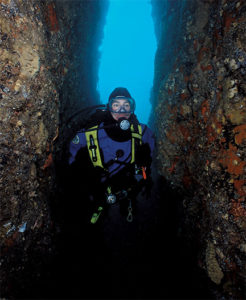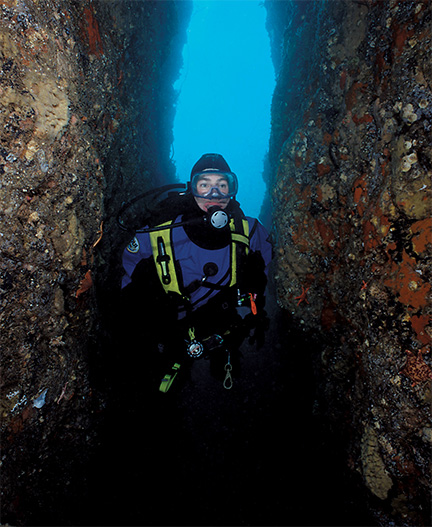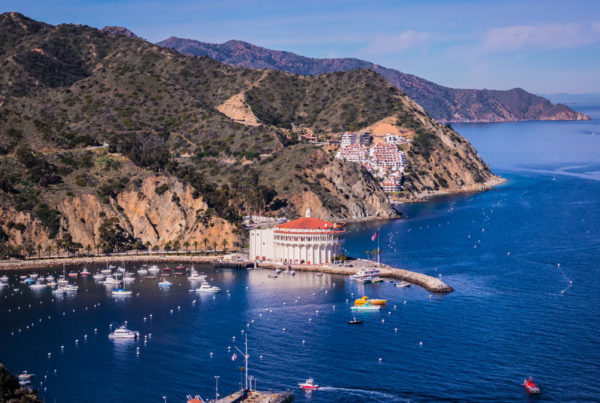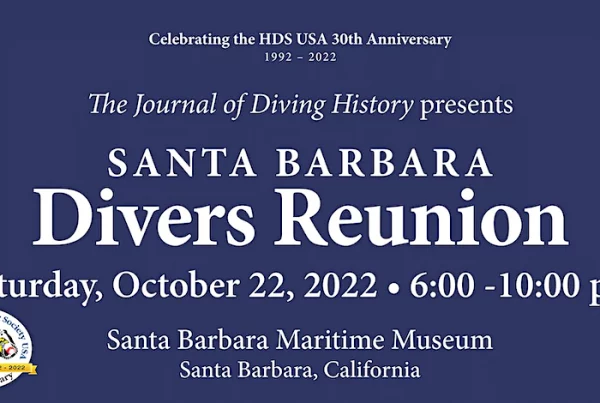 What makes a great dive site? Clear water? Varied topography? Lots of fish? Colorful invertebrates? While most great dive sites have many of these things, few will have them all. One that does have it all is a seldom-dived site in Carmel Bay that divers call Horseshoe.
What makes a great dive site? Clear water? Varied topography? Lots of fish? Colorful invertebrates? While most great dive sites have many of these things, few will have them all. One that does have it all is a seldom-dived site in Carmel Bay that divers call Horseshoe.
Horseshoe is best described as one of the outer, outer pinnacles and is a bit further offshore than the Outer Pinnacle in Carmel Bay. This site was first “discovered” using US Government bathymetry data. This is the modern way to find new dive sites—explore the ocean bottom on your computer, locate interesting topography, get a GPS location, and then go check out the site.
Horseshoe is a raised rocky area, and the bathymetry plot is shaped much like a horseshoe, with the open-end pointing roughly southeast. The high spot is about 50 feet and the deep-water surrounding the rocky area is over 90 feet. The horseshoe is surrounded by a number of narrow, steep-sided canyons and spires.
Horseshoe has one of the more rugged bottom topographies of any dive site. For those who are familiar with the American southwest, its structure looks like something in between Monument Valley and Antelope Canyon. In some areas long, steep-sided canyons wind through the rocky mass. In other spots spires jut up dramatically some 40 feet or more from the 90-foot bottom. The canyon walls are so steep that that they offer considerable protection from surge, even in a respectable swell. This makes Horseshoe a great dive site when a long wavelength swell makes shallower and less dramatic sites undiveable.
The upper portions of the rock are adorned with the most colorful cornucopia of sessile invertebrates that I have seen in many years. The hydrocoral here is particularly impressive. Some stands are big, stout and ancient. Others are tiny, and very delicate. All are pristine with scarcely a broken branch to be found. Divers should be especially vigilant of their buoyancy here to keep the coral in this pristine condition. Among the hydrocoral are patches of deeply colored orange and yellow sponges, along with pink and purple colonies of tunicates, and a few patched of strawberry anemones. Look for polished shells of chestnut cowries among the sessile invertebrates. From a distance the reef seems to glow with a rainbow of colors. This is especially true on a sunny day.
When going a bit deeper you’ll likely find the canyon walls are not as completely covered with invertebrates as the shallower portions of the reef, but the fish life is more abundant. There were several vermilion rockfish sauntering around in plain view, along with scores of gopher, copper, and brown rockfish. A large school of blue rockfish circumnavigated the rocky plateau. The presence of vermilion rockfish was particularly refreshing since fishers prize them, and their numbers have dropped over the years. There were also a number of small lingcod and a horde of gobies, kelpfish, and juvenile rockfish hiding in cracks and caves. This is a fish photographer’s or fish watcher’s paradise, since this is a reserve and the fish seem to know they are protected.
The deeper walls were sprinkled with nudibranchs, mostly Monterey dorids and yellow-edged cadlinas. The cadlinas were particularly amorous that day and most were paired off mating and laying eggs. There were also a number of Hilton’s and horned aeolids out and about. These nudibranchs have four rows of well-groomed gills. They lay eggs in strings instead of the ribbon-shaped egg cases of dorid nudibranchs.
Divers should always be aware of their surroundings and look behind them every so often. You never know what might be swimming behind you. At horseshoe California sea lions will sometimes check out divers as they pass through the area. They are naturally curious and will often pose for pictures.
Some dive sites are good for invertebrates, others are good for fish, and still others have interesting bottom topography. It is, however, unusual for sites to have it all, but Horseshoe does. Horseshoe is not divable every day because it so exposed and vulnerable to the prevailing swell. On the right day you will find no better dive in the Monterey area with both interesting marine critters and spectacular bottom topography.
At-A-Glance
Skill Level: Intermediate or better
Location: About a mile south off Pescadero Point in Carmel Bay. You will need GPS to find this site at 36° 33.300’ N, 121° 58.154’ W.
Access: Boats may be launched from the public ramps at Monterey Breakwater or between Fisherman’s Wharf and Wharf #2. Charter dive boats visit this site.
Facilities: None
Entry and Exit: Only boat access
Depth Range: 50 to 90 feet
Conditions: Highly variable
Visibility: 20 to 50 feet
Photography: Great photography of invertebrates and reef fish. Great wide-angle photography of hydrocoral and reef scenes.
Hunting: This site is within the Carmel Pinnacles State Marine Reserve and nothing may be taken.
Cautions: Watch for strong currents, surge and boat traffic.









